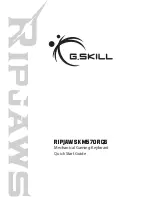
13
If your thumbs are sensitive
The Advantage2 keyboard is designed for increased thumb usage compared to a traditional keyboard which
places more strain on the little fingers. Some new Kinesis Contoured keyboard users initially experience
fatigue or discomfort as their thumbs adapt to the increased workload. If you have a preexisting thumb injury,
be especially careful to move your hands and arms when reaching for thumb keys and read the paragraph
below about thumb-free typing option.
Guidelines for using your thumbs
Avoid stretching your thumbs to reach the furthest keys in the Thumb Clusters. Instead move your hands and
arms slightly, being careful to stay relaxed, and keep your wrists straight. If your thumbs are especially
sensitive, consider using your index fingers instead of your thumbs to activate these keys. You may want to
speak with your health care professional about these options. If pain persists for more than several days, stop
using the Advantage2 keyboard and contact your health care professional for advice.
Thumb-free typing options
If your thumbs are especially sensitive, your keyboard can be configured for minimal thumb use or even
thumb-free typing if necessary. This approach is most effective when using a Kinesis foot pedal in conjunction
with the Advantage2. Generally speaking, thumb-free typing is accomplished by remapping thumb key
actions to the embedded layer, preferably accessed through an optional Kinesis foot pedal, where they can
be typed with by your fingers. Personal preference will dictate the exact details of any custom layout but see
Section 6.12 for instructions on how to remap keys.
5.0 Initially Configuring Your Keyboard
Kinesis Contoured keyboards have always featured a fully-programmable architecture that allowed users to
record macros, remap keys, and create custom layouts and settings. The Advantage2 keyboard takes that
legacy to the next level with the new SmartSet Programming Engine which adds powerful programming
features and new ways to build, view and share custom layouts. No software is required, and SmartSet works
in any operating system that supports USB keyboards. Virtually any key (168 top level and embedded level
key actions) can be copied, moved, or inactivated. In addition, dozens of heavy duty macros of (200+
characters) can be stored in the keyboard’s memory chip, to be assigned to one more custom layouts and
triggered by a single key or key combination.
What is SmartSet?
SmartSet technology is the foundation of all the “next generation” Kinesis programmable computer
peripherals. This technology was implemented in our Savant Elite2 programmable USB foot pedals in 2015
and then adapted for use in the Advantage2 keyboard in 2016. The foundation of SmartSet is using a virtual
removable drive (the “Advantage2” v-drive™) inside the device to store custom configuration settings as
“simple text” files, which can be accessed and edited from virtually any computer. In addition, the SmartSet
App is a free, no-install graphical programming tool which will be available for Advantage2 in early 2018.
Basic Onboard Programming Tools
Basic users of the keyboard can customize the keyboard via simple onboard programming shortcuts. The
saving and storing of custom configuration files to the v-drive happens behind-the-scenes (see Section 6).
Power User Tools
Advanced users can elect to activate
Power User Mode
(see Section 7) to open the v-drive on their
computer and access any of the configuration files. From the v-drive, layouts can be viewed and edited
directly, and other keyboard settings can be customized, all without the installation of any software. Since
configuration files are saved in “simple text” format, they can be opened and viewed with any basic text-editor
program, regardless of your operating system.














































